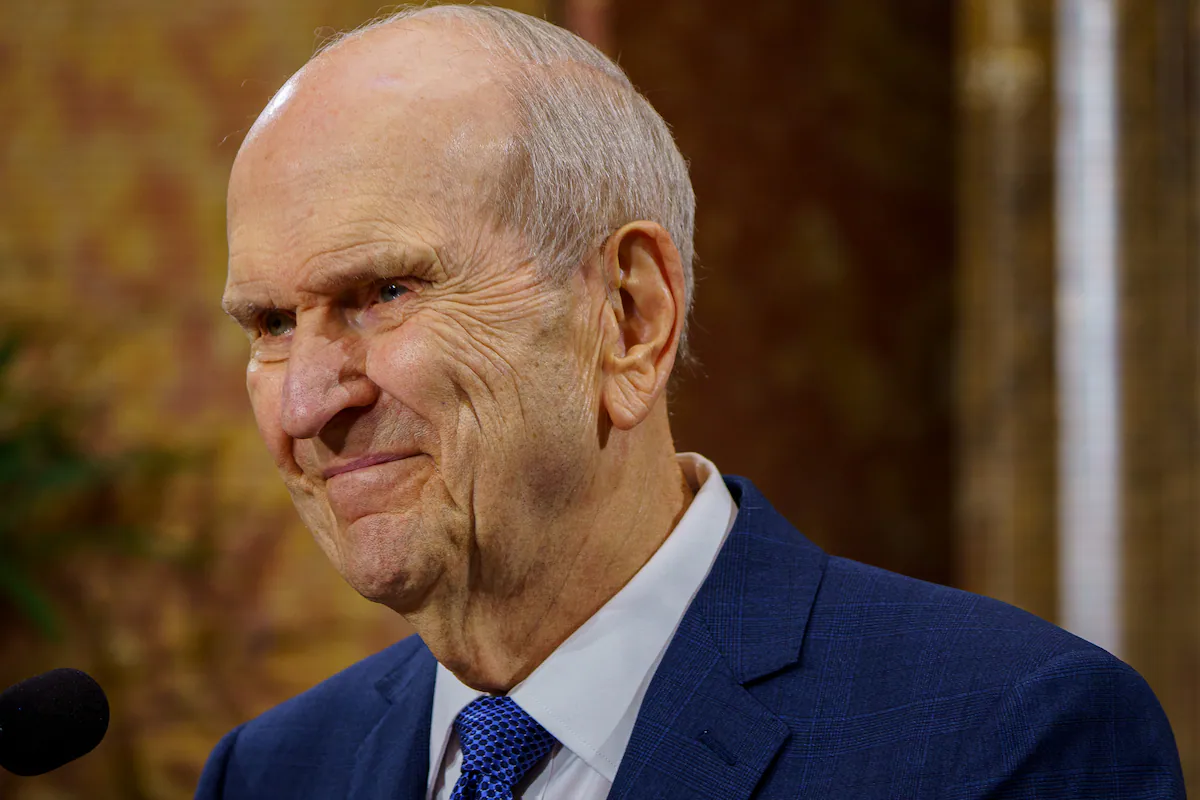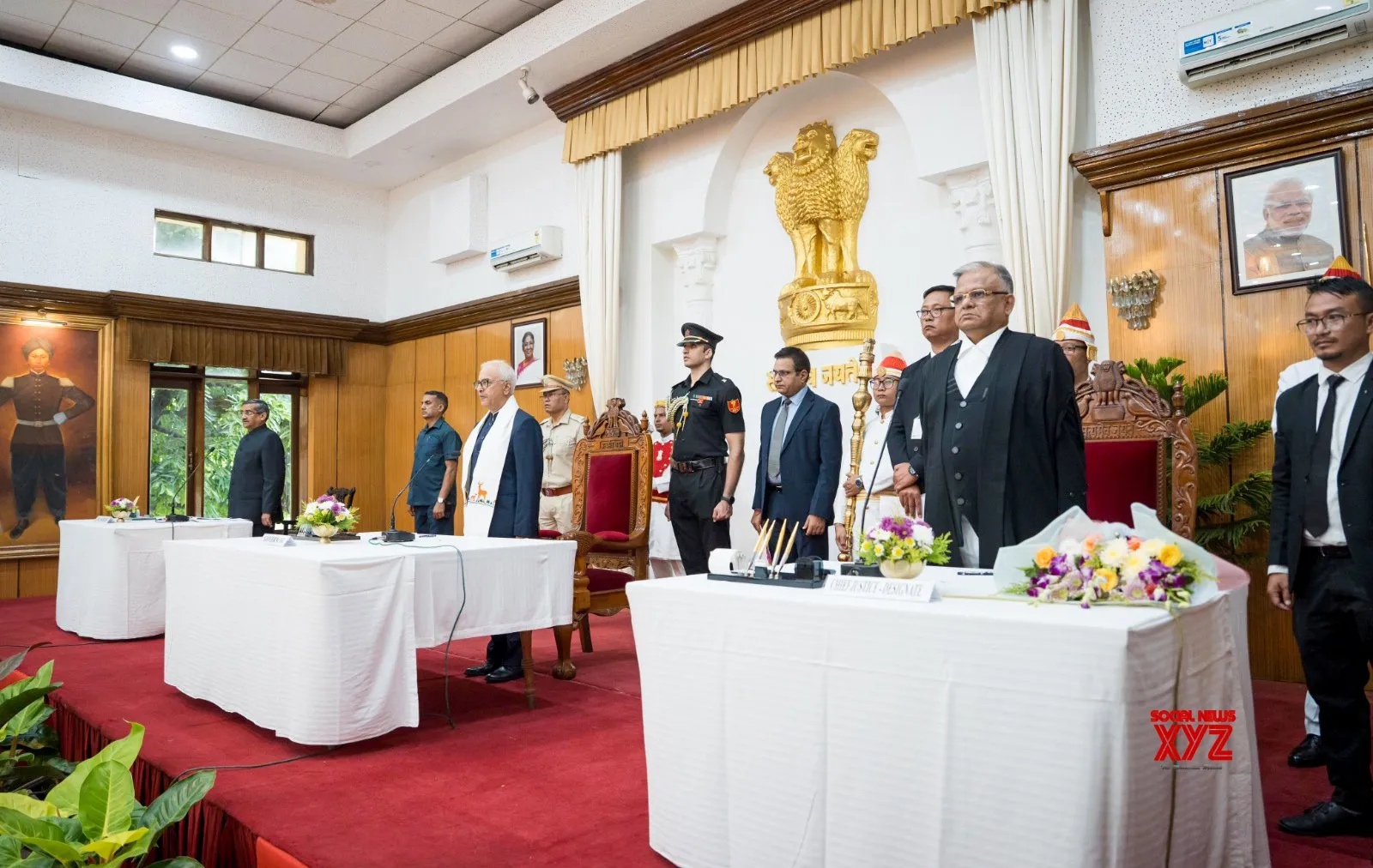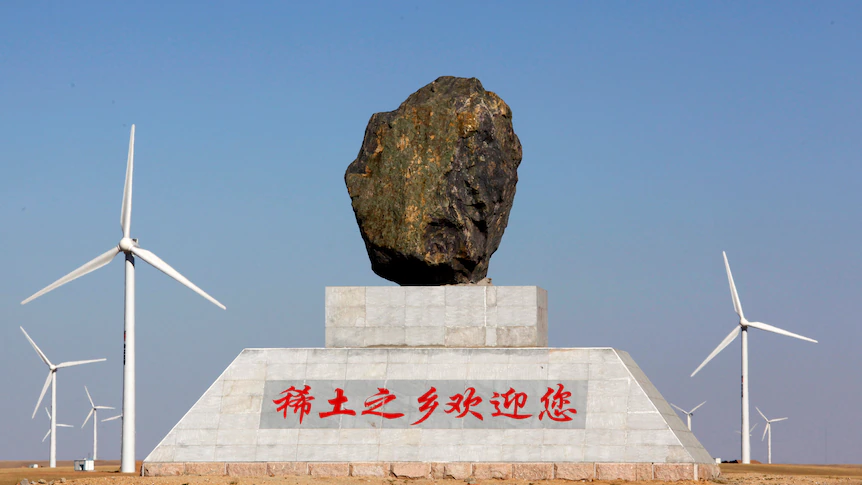
Few expected the blast of energy, enthusiasm and ingenuity that swept through The Church of Jesus Christ of Latter-day Saints when then-93-year-old Russell M. Nelson ascended to the faith’s presidency in January 2018.
After all, the former heart surgeon — who died Saturday shortly after 10 p.m. at age 101 — was the second oldest man ever to take the reins of the Utah-based faith and less familiar among members than his folksy predecessor, Thomas S. Monson.
But Nelson eventually became the faith’s first centenarian president and its oldest-ever prophet. His name quickly became synonymous with change. During his tenure, the church reversed a controversial LGBTQ policy — one he previously had vigorously defended as the “will of the Lord” — that labeled same-sex member couples “apostates” and barred their minor children from religious rites. It endorsed the federal Respect for Marriage Act, which codified same-sex marriage while protecting religious freedoms. It implemented sweeping changes to temple ceremonies — twice — adopting more inclusive language and more equitable elements for women and men while boosting the emphasis on Jesus Christ. And Nelson launched an all-out war against the nicknames “Mormon” and “LDS” when referring to the faith and its members.
He also called three new apostles — Gerrit Gong, the first Asian American, Ulisses Soares of Brazil, and Patrick Kearon of Great Britain — and set in motion an unprecedented stepped-up pace of temple building, announcing 200 new edifices, accounting for more than half of the faith’s 382 existing or planned temples (32 in Utah).
At the same, he directed a massive renovation and retrofitting of the iconic Salt Lake Temple, which included gutting its pioneer interiors and ending the use of live temple rituals.
“Eat your vitamin pills,” he urged members. “Get your rest. It’s going to be exciting.”
A man of science and a man of God
Two years after Nelson’s rise to the presidency, the world would be hit by the coronavirus, and it seemed that the church’s only top leader trained in medicine — as a man of faith and science — was well-suited to lead the global faith during the pandemic — taking never-before-attempted steps to protect church members from the disease and repeatedly urging all to get vaccinated and heed the recommendations of their governmental and health leaders.
He was forced by circumstance to introduce revisions — seen as temporary — of a very different nature. Nelson’s world travels halted, and everyone was encouraged to stay home.
Early in his administration, his personal vitality seemed to defy his biological age as he crisscrossed the planet, visiting members, missionaries and world leaders.
In 2022 and 2023, his public pace slowed. He traveled far less. In October 2022, he started sitting on a chair to deliver his highly anticipated and highly viewed General Conference addresses — an allowance, he noted, for those who “age on stage.” And the following May, he confirmed a “rumor” that he sometimes uses a walker or a wheelchair when he encounters a “small challenge” with his balance. That balance betrayed him in October 2023, when the then-99-year-old injured his back in a fall, preventing him from attending the October 2023 conference in person.
Agent of change
The prospect of change didn’t scare him off. “He thinks outside the box,” his wife, Wendy Nelson, said in a video interview. “If it’s not outside the box, he’s not that interested in it.”
In fact, her husband apparently had been hungering to shake things up even before he assumed the top post.
“It is as though he’s been unleashed,” Wendy said about 10 months into his presidency. “He’s free to finally do what he came to earth to do. … He’s free to follow through with things he’s been concerned about but could never do. Now that he’s president of [the church], he can do those things.”
Within weeks of being installed as the faith’s 17th president, Nelson weighed in on immigration, urging the U.S. government to protect from deportation hundreds of thousands of “Dreamers,” whose undocumented parents brought them to this country as children.
In February 2018, in the wake of a deadly school shooting in Florida, the newly christened prophet-president criticized U.S. laws “that allow guns to go to people who shouldn’t have them.”
By Easter, Nelson dazzled all onlookers at his first General Conference as president. He appointed the faith’s first two apostles of color, revamped its all-male priesthood quorums, transformed monthly member visits, and announced temples in unlikely locations like Russia, India and Nicaragua.
Just after that televised gathering, Nelson jetted off with his wife to visit seven countries, wowing audiences from London to Hong Kong to Harare, Zimbabwe.
Turns out, he was just getting warmed up. There would be more trips — to South America, to multiple nations in the Pacific and to Italy for the first private meeting between a Latter-day Saint prophet and a Catholic pontiff. In fact, after a little more than a year, Nelson had visited every continent as church president, save for Antarctica.
During his second General Conference in charge, he announced a much-anticipated and long-desired switch from a three-hour Sunday services schedule (in place since 1980) to two hours as part of a home-centered, church-supported approach to gospel learning, a move that would pay dividends later during the coronavirus cutbacks.
He named a dozen new temple sites and doubled down on his campaign to excise the words “Mormon” and “LDS” from Latter-day Saint lexicon, warning that using these common nicknames was a “major victory for Satan.” For evidence that this initiative was serious, the church changed its website addresses and the name of the beloved Mormon Tabernacle Choir to The Tabernacle Choir at Temple Square.
In his third General Conference, in April 2019, Nelson announced eight more temples, including one in Tooele County.
A couple of weeks later, he led a news conference unveiling a massive renovation project planned for the landmark Salt Lake Temple. Mormonism’s most beloved structure would close for some six years to strengthen the 1893 edifice against earthquakes, replace several adjoining buildings and give a face-lift to the adjoining plaza and Temple Square, one of Utah’s most visited attractions.
“You will love the results,” he pledged. “They will emphasize and highlight the life, ministry and mission of Jesus Christ in his desire to bless every nation, kindred, tongue and people.”
The need for the seismic upgrade became evident in March 2020, when a 5.7 magnitude earthquake knocked the trumpet from the hand of the Angel Moroni statue atop the temple.
Politics, pageants and race
Under Nelson and his two First Presidency counselors, Dallin H. Oaks and Henry B. Eyring — all in their 90s — the church opposed Utah’s medical-marijuana ballot proposal. Voters approved the measure, but the Legislature quickly shelved it and put in its place a law the state’s predominant faith supported.
In a gesture of racial unity, Nelson met with top representatives of the NAACP and formed a partnership with the nation’s oldest civil rights organization on jobs and education initiatives. He presided over an epic 40th anniversary celebration of the end to the church’s racist priesthood and temple ban against Black members. And, in May 2018, faith said it was severing its more-than-century-old ties with the Boy Scouts of America in favor of creating its own global program for children and youths, a move that had been in the works for a number of years.
The announcement, adjustments, rescissions and reforms kept coming at a dizzying pace: major pageants (like the ones in Manti and upstate New York, where the faith was born) ended and work on a new hymnbook began. Full-time missionaries now can call home once a week (instead of twice a year) and female proselytizers can wear dress pants (except to Sunday services). Bishops’ one-on-one interviews were expanded so that members can invite another adult to sit in on the conversations, and 11-year-old boys can be ordained deacons and 11-year-old girls can join the Young Women program the year they turn 12 instead of waiting for their birthdays.
One of his momentous changes was to end the one-year waiting period between a civil marriage and a temple “sealing” for Latter-day Saint couples everywhere.
Such bold actions on social policy and church procedures provided members with an emotional lift, and made General Conference and virtually every Nelson speech must-see TV.
It was an auspicious run for a man whose life and career were spent outside the church bureaucracy and hierarchy.
A year like no other
In fall 2019, Nelson told members that because the April 2020 General Conference was the 200th anniversary of what Latter-day Saints believe was the inaugural event of their faith — founder Joseph Smith’s “First Vision” — it was going to be momentous and memorable.
By early March, however, the virus was spinning out of control in many countries, including the U.S., so the First Presidency decided to hold the conference virtually, rather than in person, a practice that would continue for several more conferences.
Many speakers, addressing members online, did mention Smith’s encounter with deity, but the biggest news came at the end — the announcement of a temple being built in the United Arab Emirates, the church’s first in the Middle East, and in mainland China, whose government has cracked down on religious freedom.
Later in March, the church brought back many of its 65,000-volunteer missionary force to their home countries, suspended weekly church services and closed its temples.
By the next conference in October — also held virtually — some missionaries had returned to their service, whether to their original assignments or to temporary placements, and some congregations were meeting in small groups in person, while others watched on Zoom.
Some temples, too, had begun to open, at least for “live” ceremonies, rather than proxy rituals for the dead.
Also at that conference, Nelson unequivocally denounced racism and urged members to lead out against prejudice.
“I assure you that your standing before God is not determined by the color of your skin,” the then-96-year-old prophet told Latter-day Saints watching online. “Favor or disfavor with God is dependent upon your devotion to God and his commandments, and not the color of your skin.”
Head and heart
Nelson’s skills as a cardiothoracic surgeon from the 1950s to the mid-1980s earned him national and international acclaim.
In 1980, he trained heart surgeons at three universities in China, and it was there, in 1985, that he performed his last open-heart surgery.
For Latter-day Saints, though, Nelson’s most famous patient was one of his prophet-predecessors, Spencer W. Kimball.
In 1964, Kimball, then an apostle, appointed Nelson as a stake president to oversee a number of area congregations in Salt Lake City. This call came at the height of the surgeon’s pioneering work on aortic valve replacement.
“In the blessing that [Kimball] pronounced upon my head that day, he specifically blessed me that our mortality rates with aortic valve surgery in particular would be reduced,” Nelson is quoted as saying in an official church biography. “…In fact, our mortality rates went down to where they are today — at a very low and acceptable, tolerable range.”
Eight years later, Nelson would perform the same operation on Kimball, after which the surgeon had a “personal witness that his patient would someday become president of the church.”
That’s exactly what happened to Kimball, the Yoda-like leader with the scratchy voice, in 1973.
Nelson himself joined the Quorum of the Twelve Apostles in 1984, serving for more than three decades before becoming the faith’s top “prophet, seer and revelator.”
Throughout his life, Nelson held fast to “a deep and abiding faith in God and in his son, Jesus Christ,” he said in the church’s Ensign magazine. “The work I’m now engaged in is the most important cause in the world. It’s all-encompassing, it’s fulfilling, and it’s challenging. And I must do my best, because I have an accountability for this stewardship.”
That sense of drive and duty had been with him from his earliest years.
Family life
Russell Marion Nelson was born Sept. 9, 1924, in Salt Lake City, the second of four children born to Marion C. and Edna Anderson Nelson.
“All eight of my great-grandparents were converts to the church in Europe,” the then-newly sustained president said in his first lengthy talk in General Conference. “During subsequent generations, however, not all my ancestors remained so committed. As a result, I was not raised in a gospel-centered home.”
That meant the man who would one day lead the 17 million-member church was not baptized until he was in his teens, nor did he serve a full-time mission.
Despite his disappointment with the lack of a religious upbringing, Nelson said his was a happy home, where his parents allowed him to flourish in any and all enterprises he chose.
Young Russell played football, for example, at least officially. A church biography notes that Nelson suited up with his high school team, but the surgeon-to-be “didn’t want his hands to get stepped on.” So the coach relegated him to the bench. Nelson later used those hands to perform surgery on his ex-coach.
During high school, he formed a love for biology and math.
“And I loved people,” he told a University of Utah Dean’s Roundtable discussion in 2014. “I told Mom and Dad, ‘I don’t want to disappoint you, but I want to be a doctor.’ ”
So Nelson set off toward that goal. He earned his medical degree, with highest honors, from the U. in 1947 and was part of a research team that developed the heart-lung machine that made possible the first human open-heart surgery in 1951.
He spent two years as an Army medical officer during the Korean War, serving in Korea and Japan and at Walter Reed Army Medical Center in Washington. After the conflict, Nelson received additional surgical training at Harvard Medical School’s Massachusetts General Hospital in Boston.
In 1955, he returned to Utah to accept a faculty post at his alma mater, the U.’s medical school, where he conducted the state’s first open-heart surgery. In 2023, he donated his medical journals, including 30 books documenting more than 7,000 surgeries, to his alma mater.
Nelson had delved into heart studies at a time when few medical experts undertook such work.
“When we were in medical school, we were taught that one must never touch the beating heart,” Nelson recalled during an alumni event in 2015 at the U. “If you touched it, it would stop beating.”
Of course, Nelson ended up spending most of his life touching people’s hearts — first with a scalpel in his hand and then with sermons from his soul.
‘Women? We love ’em’
Nelson met his first wife, Dantzel White Nelson, when they starred together in a play at the U. She was a lead soprano, and he was her male counterpart. When he heard her sing, young Russell was “smitten,” the profile said. They married three years later in August 1945 in the Salt Lake Temple.
The pair raised 10 children — nine daughters and one son — before her death in 2005. Nelson remarried in 2006, making Wendy L. Watson, an author and church speaker in her own right, his wife. (Nelson’s daughter Wendy Nelson Maxfield died in January 2019 of cancer at age 67.)
In October 2015, during his first General Conference speech after taking the helm of the Quorum of the Twelve Apostles, Nelson challenged Latter-day Saint women to “speak up and speak out” during leadership meetings in their congregations and in their homes.
His push came amid a continuing debate about the role of women inside the church. Some are calling for female ordination to the all-male priesthood; others are seeking more visibility in the higher echelons and a greater voice in key decisions.
“We need your impressions, your insights and your inspiration. We need you to speak up and speak out in ward and stake councils. We need each married sister to speak as a ‘contributing and full partner’ as you unite with your husband in governing your family,” he told Latter-day Saint women throughout the world. “Married or single, you sisters possess distinctive capabilities and special intuition you have received as gifts from God. We brethren cannot duplicate your unique influence.”
When asked about women in his first news conference as church president, Nelson quipped: “We love ’em.”
“I’m the father of nine beautiful daughters,” he said. “Those girls are now mothers of their own … and grandmothers. We need their voices, their input and we love their participation with us.”
Nelson noted further that “we have women on our councils, women administering ordinances in the temples. … We depend on their voices.”
On Jan. 2, 2019, the church unveiled a new temple endowment ceremony that members said removed a number of “sexist” elements.
Many women — and men — had complained for years about language in the ordinance, which includes ritual reenactments of the creation, Adam and Eve’s expulsion from the Garden of Eden and humankind’s mortal journey and ultimate return to God’s presence.
Now, those women and men make all the same covenants, or promises, to God, rather than separate ones.
“If you ask any faithful feminist what she wanted to change, these hit the entire checklist,” said a woman who attended the Philadelphia Temple soon after the change. “Every single complaint was addressed and fixed in a meaningful way. This was not a baby step; it was like a leap forward.”
More temple changes followed in 2023, further enhancing gender equity and providing more explanations of the promises participants make to God.
Nelson invited female members to take part in a 10-day fast from social media (similar to the one he had earlier urged the church’s youths to undertake). And he prodded male Latter-day Saints to tune out the TV and tune in to their families. “Get up off the couch, put down the remote, and wake up from [your] spiritual slumber.”
Traversing the globe
After serving in various ward- and stake-level leadership positions, Nelson became the church’s general president for Sunday school programs in 1971 and then was called as a regional church representative in 1979.
A year after becoming an apostle at 59, he led the church’s Eastern European operations, helping to expand the faith’s presence in the former Soviet bloc nations.
In all, according to Spencer J. Condie’s 2003 biography, “Russell M. Nelson: Father, Surgeon, Apostle,” Nelson visited 110 nations as a church representative, flying not only to European locales but also to Central Asia and China — using his fluency in Mandarin in the latter case to strengthen ties between the American and Chinese medical communities.
And that was all before he became president.
The ‘R’ word
As a senior apostle, Nelson increasingly urged Latter-day Saints to resist challenges to the faith’s core beliefs and evolving policies — and said most changes were “revelations” from God.
In a January 2016 sermon to Mormon millennials, he defended the church’s then-new stance that labeled same-sex member couples “apostates” and generally forbid their children from baptism and other religious rites until they turn 18.
Nelson declared that the policy represented “the mind of the Lord and the will of the Lord” as revealed to Monson, the faith’s prophet.
He urged his young audience members to stay true to the faith and defend it against critics.
“The somber reality is that there are ‘servants of Satan’ embedded throughout society,” he said. “So be very careful about whose counsel you follow.”
The safest course, Nelson advised, is to heed the words of top church leaders.
“Prophets see ahead. They see the harrowing dangers the adversary has placed, or will yet place, in our path,” he said. “Prophets also foresee the grand possibilities and privileges awaiting those who listen with the intent to obey.
“ … You may not always understand every declaration of a living prophet,” he added. “But when you know a prophet is a prophet, you can approach the Lord in humility and faith and ask for your own witness about whatever his prophet has proclaimed.”
Nearly 3 1/2 years later, though, Nelson and his counselors walked back that policy, which had disillusioned LGBTQ allies, disappointed even active members, triggered widespread protests, tore apart families and prompted hundreds if not thousands either to resign from the church or retreat from attending services.
Nelson and his counselors couched the revision in the language of revelation, suggesting that God had now instructed top church leaders to adopt this new stance.
“We need the Lord’s direction to meet changing circumstances,” Eyring said in a news release, “and he has guided changes in practice and policy throughout the history of the church.”
The First Presidency said the policy shift came “after an extended period of counseling with our brethren in the Quorum of the Twelve Apostles and after fervent, united prayer to understand the will of the Lord on these matters.”
In April 2023, Nelson delivered what some observers have called his greatest speech, encouraging Latter-day Saints to be peacemakers.
“Civility and decency seem to have disappeared during this era of polarization and passionate disagreements. Vulgarity, fault finding and evil speaking of others are all too common,” he lamented. “Too many pundits, politicians, entertainers and other influencers throw insults constantly. I am greatly concerned that so many people seem to believe that it is completely acceptable to condemn, malign and vilify anyone who does not agree with them. Many seem eager to damage another’s reputation with pathetic and pithy barbs.”
Instead, he pleaded, members should “lay aside bitterness … to cease insisting that it is your way or no way. … Now is the time to bury your weapons of war.”
Nelson, more than many of his predecessors, was comfortable speaking about receiving divine direction, especially at night. He once said that he was awakened at 2 a.m. with a distinct impression that he should go to the Dominican Republic. Within days, the energetic nonagenarian was on a plane to the Caribbean nation.
In a March 2019 Church News video interview, Wendy Nelson shed additional light on her husband’s moonlit messages.
“My husband will say during the night, ‘OK, Dear, it’s happening,’” she said. “I just remain quiet and then soon he’s sitting up at the side of the bed writing, now with a lighted pen that someone gave him.”
Similar inspiration prompted Nelson to invite his two counselors and all 12 members of the Quorum of the Twelve Apostles to gather in Rome in advance of the March 2019 dedication of the faith’s first temple in Italy. It marked the first time in Mormon history that all 15 leaders were in one location outside the United States. None of the faith’s top female leaders, however, was there.
During his time in the Eternal City, the cradle of Catholicism, Nelson — joined by M. Russell Ballard, acting president of the Quorum of the Twelve — met with Pope Francis at the Vatican.
“What a sweet, wonderful man he is,” the Latter-day Saint president said of his host, “and how fortunate the Catholic people are to have such a gracious, concerned, loving and capable leader.”
During their 33-minute exchange, the leaders discussed family values, religious freedom, global relief and the two faiths’ mutual efforts to relieve human suffering.
While the historic encounter was not as significant for the world’s 1.2 billion Catholics — popes frequently give audiences to foremost religious figures — the spiritual calculus added up to watershed recognition for the globe’s Latter-day Saints.
Revelation — both personal and prophetic — was the topic of his first lengthy conference address after being named church president.
“I urge you to stretch beyond your current spiritual ability to receive personal revelation,” their leader advised millions of Latter-day Saints that day, “for the Lord has promised that ‘if thou shalt [seek], thou shalt receive revelation upon revelation, knowledge upon knowledge, that thou mayest know the mysteries and peaceable things—that which bringeth joy, that which bringeth life eternal.’”
Nelson also reiterated how he came to know God’s instructions for the church.
“When we convene as a Council of the First Presidency and Quorum of the Twelve, our meeting rooms become rooms of revelation. The Spirit is palpably present,” he said. “As we wrestle with complex matters, a thrilling process unfolds as each apostle freely expresses his thoughts and point of view.”
The men feel constant love for each other, Nelson said. “Our unity helps us to discern the Lord’s will for his church.”
Stuart Reid, a former Utah legislator who previously worked in the church’s public affairs department, believes that Nelson’s use of the term “revelation” is no accident but rather reflects the Latter-day Saint leader’s real interactions with divinity.
“The Lord really does speak to him in the night,” Reid said on The Salt Lake Tribune’s “Mormon Land” podcast. “He is a person who seeks revelation and insight … of what the Lord expects of this church.”
Nelson was preparing the faithful for the long-awaited Second Coming of Christ, Reid said, and relaying God’s will was a key factor in that readying.
In an April 2019 conference address, Nelson pleaded with those who have distanced themselves from the church or never truly considered converting to “do the spiritual work to find out for yourselves, and please do it now.”



